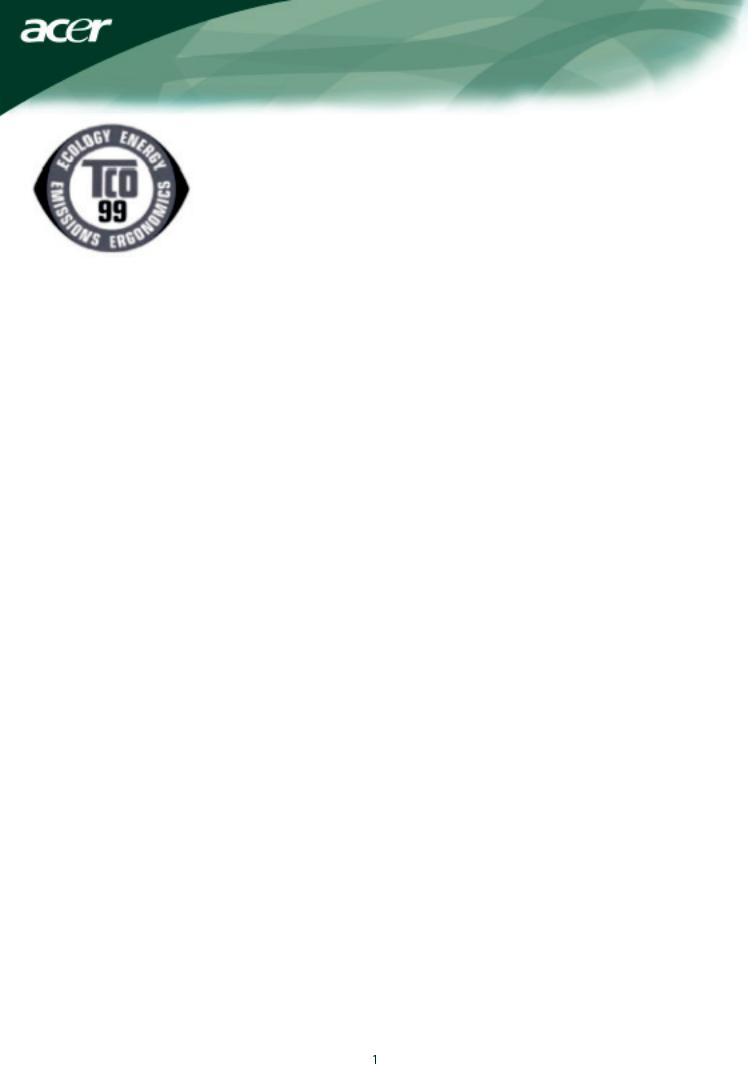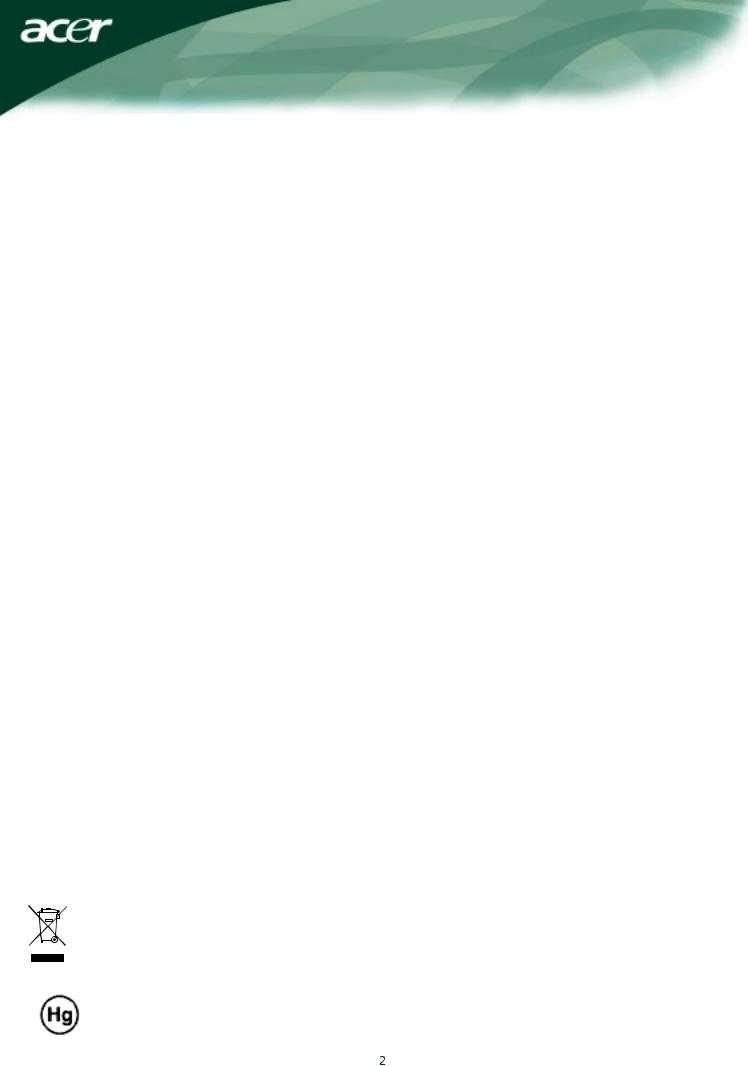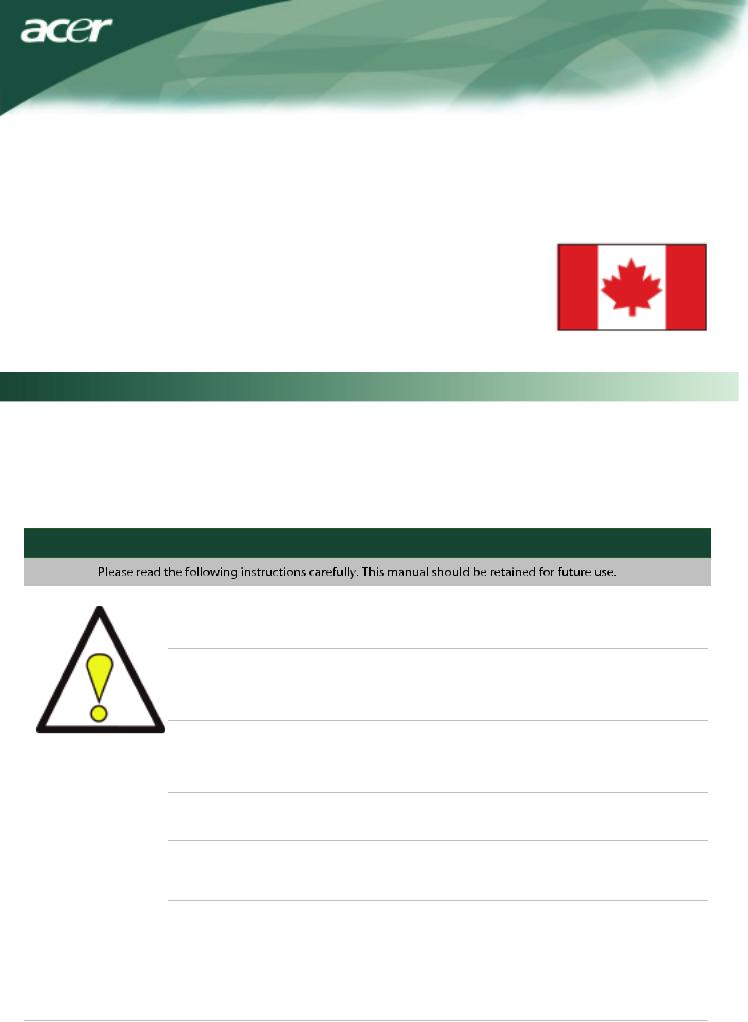Acer AL2016 Manual

Table of Contents |
|
TCO99 Notice............................................................................................................................................................ |
1 |
FCC Statement Warning............................................................................................................................................ |
2 |
Canadian DOC Notice............................................................................................................................................... |
3 |
Precautions................................................................................................................................................................ |
3 |
Package Contents...................................................................................................................................................... |
4 |
Installation Instructions.............................................................................................................................................. |
4 |
Assembling the Monitor................................................................................................................................... |
4 |
Detaching the Monitor ..................................................................................................................................... |
4 |
Adjusting the Viewing Angle ........................................................................................................................... |
4 |
Connecting the Devices .................................................................................................................................. |
4 |
Switching the Power ....................................................................................................................................... |
5 |
Adjusting Display Settings ......................................................................................................................................... |
5 |
External Controls ............................................................................................................................................ |
5 |
OSD Options ............................................................................................................................................................. |
5 |
OSD Menu ...................................................................................................................................................... |
6 |
Brightness & Contrast ............................................................................................................................. |
6 |
Tracking ................................................................................................................................................. |
6 |
Position ................................................................................................................................................... |
6 |
Color ....................................................................................................................................................... |
6 |
Language Setting..................................................................................................................................... |
7 |
OSD Option............................................................................................................................................. |
|
|
7 |
Auto Configuration................................................................................................................................... |
|
|
7 |
Information ............................................................................................................................................ |
7 |
Recall....................................................................................................................................................... |
7 |
General Specifications............................................................................................................................................... |
8 |
Technical Information................................................................................................................................................. |
8 |
Pin Assignment ................................................................................................................................................ |
8 |
Standard Timing Table..................................................................................................................................... |
9 |
Troubleshooting................................................................................................................................................ |
|
|
10 |

Page1-2 stands for TCO'99 model only.
Please see back label for model distinction.
Congratulations!
You have just purchased a TCO'99 approved and labelled product! Your choice has provided you with a product developed for professional use. Your purchase has also contributed to reducing the burden on the environment and also to the further development of environmentally adapted electronics products.
Why do we have environmentally labelled computers?
In many countries, environmental labelling has become an established method for encouraging the adaptation of goods and services to the environment. The main problem, as far as computers and other electronics equipment are concerned, is that environmentally harmful substances are used both in the products and during their manufacture. Since it is not so far possible to satisfactorily recycle the majority of electronics equipment, most of these potentially damaging substances sooner or later enter nature. There are also other characteristics of a computer, such as energy consumption levels, that are important from the viewpoints of both the work (internal) and natural (external) environments. Since all methods of electricity generation have a negative effect on the environment (e.g. acidic and climate-influencing emissions, radioactive waste), it is vital to save energy. Electronics equipment in offices is often left running continuously and thereby consumes a lot of energy.
What does labelling involve?
This product meets the requirements for the TCO'99 scheme, which provides for international and environmental labelling of personal computers. The labelling scheme was developed as a joint effort by the TCO (The Swedish Confederation of Professional Employees), Svenska Naturskyddsforeningen (The Swedish Society for Nature Conservation) and Statens Energimyndighet (The Swedish National Energy Administration). Approval requirements cover a wide range of issues: environment, ergonomics, usability, emission of electric and magnetic fields, energy consumption and electrical and fire safety. The environmental demands impose restrictions on the presence and use of heavy metals, brominated and chlorinated flame retardants, CFCs (freons) and chlorinated solvents, among other things. The product must be prepared for recycling and the manufacturer is obliged to have an environmental policy which must be adhered to in each country where the company implements its operational policy. The energy requirements include a demand that the computer and/or display, after a certain period of inactivity, shall reduce its power consumption to a lower level in one or more stages. The length of time to reactivate the computer shall be reasonable for the user. Labelled products must meet strict environmental demands, for example, in respect of the reduction of electric and magnetic fields, physical and visual ergonomics and good usability. On the Back page of this folder, you will find a brief summary of the environmental requirements met by this product. The complete environmental criteria document may be ordered from:
TCO Development
SE-114 94 Stockholm, Sweden Fax: +46 8 782 92 07 Email (Internet): development@tco.se Current information regarding TCO'99 approved and labeled products may also be obtained via the Internet, using the address:
http://www.tco-info.com/

Environmental Requirements
Flame Retardants
Flame retardants are present in printed circuit boards, cables, wires, casings and housings. Their purpose is to prevent, or at least to delay the spread of fire. Up to 30% of the plastic in a computer casing can consist of flame retardant substances. Most flame retardants contain bromine or chloride, and those flame retardants are chemically related to another group of environmental toxins, PCBs. Both the flame retardants containing bromine or chloride and the PCBs are suspected of giving rise to severe health effects, including reproductive damage in fish-eating birds and mammals, due to the bio-accumulative* processes. Flame retardants have been found in human blood and researchers fear that disturbances in foetus development may occur. The elevant TCO'99 demand requires that plastic components weighing more than 25 grams must not contain flame retardants with organically bound bromine or chlorine. Flame retardants are allowed in the printed circuit boards since no substitutes are available.
Cadmium
Cadmium is present in rechargeable batteries and in the colour-generating layers of certain computer displays. Cadmium damages the nervous system and is toxic in high doses. The relevant TCO'99 requirement states that batteries, the color-generating layers of display screens and the electrical or electronics components must not contain any cadmium.
Mercury
Mercury is sometimes found in batteries, relays and switches. It damages the nervous system and is toxic in high doses. The relevant TCO'99 requirement states that batteries may not contain any mercury. It also demands that mercury is not present in any of the electrical or electronics components associated with the labelled unit.
CFCs (freons)
The relevant TCO'99 requirement states that neither CFCs nor HCFCs may be used during the manufacture and assembly of the product. CFCs (freons) are sometimes used for washing printed circuit boards. CFCs break down ozone and thereby damage the ozone layer in the stratosphere, causing increased reception on earth of ultraviolet light with e.g. increased risks of skin cancer (malignant melanoma) as a consequence.
Lead**
Lead can be found in picture tubes, display screens, solders and capacitors. Lead damages the nervous system and in higher doses, causes lead poisoning. The relevant TCO'99 requirement permits the inclusion of lead since no replacement has yet been developed.
*Bio-accumulative is defined as substances which accumulate within living organisms
**Lead, Cadmium and Mercury are heavy metals which are Bio-accumulative.
FCC Statement Warning
This equipment has been tested and found to comply with the limits for a Class B digital device, pursuant to Part 15 of the FCC Rules. These limits are designed to provide reasonable protection against harmful interference in a residential installation. This equipment generates, uses, and can radiate radio frequency energy, and if not installed and used in accordance with the instruction, may cause harmful interference to radio communications. However, there is no guarantee that interference will not occur in a particular installation. If this equipment does cause harmful interference to radio or television reception, which can be determined by turning the equipment off and on, the user is encouraged to try to correct the interference by one or more of the following measures:
.Reorient or relocate the receiving antenna.
. Increase the separation between the equipment and the receiver.
. Connect the equipment into an outlet on a circuit different from that to which the receiver is connected.
. Consult the dealer or an experienced radio/TV technician for help.
Any changes or modifications not expressly approved by the manufacturers may void the user's authority to operate this equipment.
WEEE Disposal Instructions
Do not throw this electronic device into the municipal trash bin when discarding. To minimize pollution and ensure utmost protection of the global environment, please recycle it. For more information about the collection of WEEE welcome to visit our homepage at www.acer.com under environment.
Lamp Disposal
LAMP(S) INSIDE THIS PRODUCT CONTAIN MERCURY AND MUST BE RECYCLED OR DISPOSED OF ACCORDING TO LOCAL, STATE OR FEDERAL LAWS. FOR MORE INFORMATION, CONTACT THE ELECTRONIC INDUSTRIES ALLIANCE AT WWW.ELAE.ORG. FOR LAMP SPECIFIC DISPOSAL INFORMATION CHECK WWW. LAAMPRECYCLE.ORG.

NOTE
A shielded-type signal cord is required in order to meet the FCC emission limits and also to prevent interference to the radio and television reception. It is essential that only the supplied signal cord be used.
Canadian DOC Notice
This Class B digital apparatus meets all requirements of the Canadian InterferenceCausing Equipment Regulations.
Cet appareil numerique de la classe B repecte toutes les exigences du Reglement sur le materiel brouilleur du Canada.
Preface
This manual is designed to assist users in setting up and using the LCD Monitor. Information in his document has been carefully checked for accuracy; however, no guarantee is given to the correctness of the contents. The information in this document is subject to change without notice. This document contains proprietary information protected by copyright. All rights are reserved. No part of this manual may be reproduced by any mechanical, electronic or other means, in any form, without prior written permission of the manufacturer.
Important Safety Instructions
1.To clean LCD Monitor screen;Power off LCD Monitor and unplug the AC Cord. Spray a non-solvent cleaning solution onto a rag and clean the screen gently.
2.Do not place the LCD Monitor near a window. Exposing the monitor to rain water, moisture or sunlight can severely damage it. ter, moisture or sunlight can severely damage it.
3.Do not place the LCD Monitor near a window. Exposing the monitor to rain water, moisture or sunlight can severely damage it. ter, moisture or sunlight can severely damage it.
4.Do not remove the cover or attempt to service this unit by yourself. Servicing of any nature should be performed by an authorized technician.
5.Operate LCD Monitor in a room with a room temperature of 5°C ~ 40°C (or 41°F ~ 104°F).Operating the LCD Monitor outside this range could result in permanent damage.
6.If any of the following occurs, immediately unplug your monitor and call an authorized technician.
*Monitor to PC signal cable is frayed or damaged.
*Liquid spilled into LCD Monitor or the monitor has been exposed to rain.
*LCD Monitor or the case is damaged.
3
